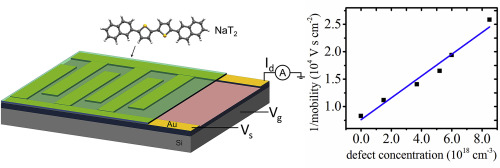Organic Electronics ( IF 2.7 ) Pub Date : 2020-03-14 , DOI: 10.1016/j.orgel.2020.105717 Paweł Piotr Cielecki , Till Leißner , Mehrad Ahmadpour , Morten Madsen , Horst-Günter Rubahn , Jacek Fiutowski , Jakob Kjelstrup-Hansen

|
The field of organic field-effect transistors (OFETs) has matured over the past two decades and devices with charge carrier mobilities of several cm2/Vs have been demonstrated. Nevertheless, to enter commercial products, the operational stability of OFET technology also needs to be addressed. Herein, two potential degradation mechanisms occurring in N,N′-di-1-naphthalenyl-N,N′-diphenyl [1,1':4′,1″:4″,1‴-quaterphenyl]-4,4‴-diamine (4P-NPD)-based OFETs are investigated. Electrical transfer characteristics show that photo-induced oxidation of the organic thin-film decreases the hole mobility and increases the threshold voltage. The inverse hole mobility depends approximately linearly on the concentration of photo-induced defect states, which is in agreement with the Multiple Trapping and Release model. This implies that the created defects act as hole traps located energetically above the highest occupied molecular orbital level. In contrast, electrical stress increases the threshold voltage without affecting the hole mobility. This behavior is related to charge trapping, which probably take place in the gate dielectric as indicated by a relatively long trapping time of ∼102 s. Time-resolved photoluminescence spectroscopy, which proved to be sensitive to both mobile and trapped charges, shows that the threshold voltage shift is caused exclusively by charge accumulation. The obtained results broaden the fundamental knowledge about the degradation processes occurring in OFETs, which is highly relevant for increasing their stability.
中文翻译:

有机场效应晶体管的光诱导和电降解
在过去的二十年中,有机场效应晶体管(OFET)的领域已经成熟,并且已经证明了具有几cm 2 / Vs的载流子迁移率的器件。然而,要进入商业产品,还必须考虑OFET技术的操作稳定性。在此,在N,N'-二-1-萘基-N,N中发生两种潜在的降解机理研究了基于'-二苯基[1,1':4',1'':4“,1′-四苯基] -4,4′-二胺(4P-NPD)的OFET。电转移特性表明,有机薄膜的光诱导氧化会降低空穴迁移率并增加阈值电压。空穴的反向迁移率大约线性地取决于光致缺陷状态的浓度,这与多重陷阱和释放模型一致。这意味着,所产生的缺陷起着空穴陷阱的作用,位于能量最高占据分子轨道的上方。相反,电应力在不影响空穴迁移率的情况下增加了阈值电压。此行为与电荷俘获有关,电荷俘获可能发生在栅极电介质中,如约10 2的相对较长的俘获时间所示 s。时间分辨的光致发光光谱证明对移动电荷和捕获电荷都敏感,它表明阈值电压偏移完全由电荷累积引起。获得的结果拓宽了关于在OFET中发生的降解过程的基础知识,这对于提高其稳定性至关重要。











































 京公网安备 11010802027423号
京公网安备 11010802027423号